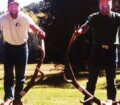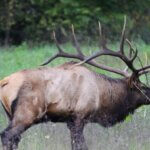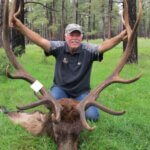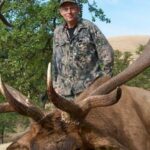Editor’s Note: Mark Hanson, from Mesa, Arizona, has a severe case of elk addiction. Mark took his first bull in 1984 with a bow—a spike with brow tines (a legal bull)—that really hooked him on elk hunting. Since then, he’s taken many bulls with his bow and two in Colorado with a rifle. However, he’s called in numerous bulls for friends and family members—about 100+ bulls. When Hanson isn’t hunting bull elk to take for himself, he hunts with friends and relatives yearly to help record their hunts, finds bulls for them, calls bull elk, and carries out the meat.
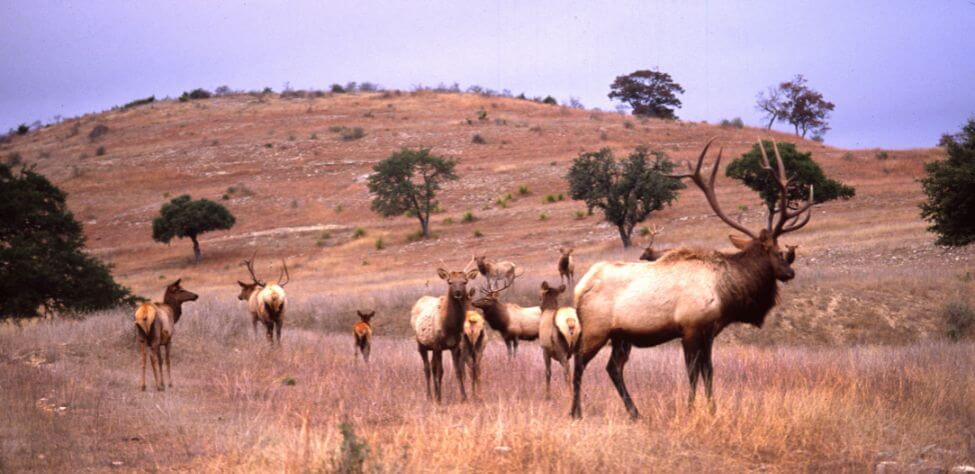
On Friday night (see Day 2), my son Paul, arrived, and we decided to hunt the bull I’d seen on Friday. I knew I’d have to hunt him in the afternoon. On Friday, I hiked up the trail near the top of the ridge. But we decided if we got up early enough on Saturday, instead of hiking up to the ridge, we’d drive my truck up an old logging road that would put us closer to the top of the ridge well before daylight. We did. I left my truck, which was near the meadow that the herd moved back and forth from to their bedding area to feed. As soon as we exited the truck, I heard the bull bugling up on top of the ridge about 1/4-mile away from us. We ran about 100 yards up the ridge to get ahead of the herd. We found a spot about 20 yards off the trail, where we could set up in some brush and see the trail. However, the elk couldn’t see or smell us. We decided to wait for the bull to bugle again to know where he was.
We heard the cows coming down the trail. When the lead cow got even with us, she looked straight at us. We almost held our breath. But the other cows coming behind her pushed her with their heads, forcing her to continue down the trail. That’s when I knew that my Mossy Oak Bottomland camo truly could make us invisible. As soon as the cows had passed us, we spotted the bull about 15 yards on the other side of the trail; the cows had come down. He was pushing one of the last cows that had gotten off the trail to try to get her back on the trail. I knew I needed to stop him and gave him a soft cow call.
The bull elk stopped beside me in his tracks, looking for the cow he just heard. I was at full draw, and then I released the arrow. I watched the arrow in flight and saw it hit just a bit high above the spot where I was aiming. When he took the arrow, the bull started running in the same direction the cows had been walking. After a 40-yard sprint, the bull turned, veered off to the right, and ran about 60 yards out of sight. Next, I heard him stop. About two minutes passed, and finally, I heard the bull fall.
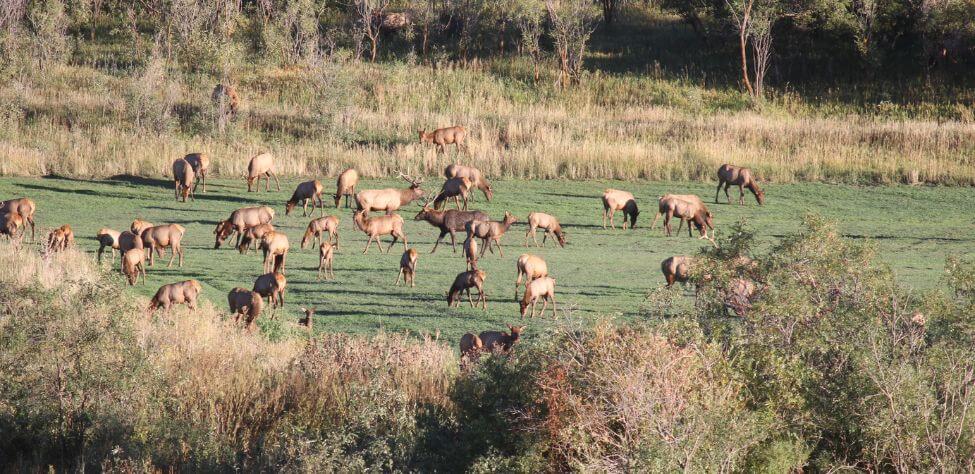
My son and I waited about 1/2-hour. We went to the spot where I’d shot the bull and located my arrow. I’d gotten a clean pass-through. I picked up the arrow, followed the blood trail, and found my elk. I sent my son to the truck to drive back to camp to pick up our frame packs, knives, and saw so we could start butchering the elk and cutting up the meat.
While Paul was in camp, he met an older couple who’d been cutting firewood near us and told them about the hunt. They wanted to ride back with him to see my elk. When they arrived at the place where we’d left the truck that morning, my son got the frame packs and my butchering equipment out. The older gentleman and his wife were still sitting in the cab when he said, “Why don’t you drive the truck closer to where your dad shot the elk?” “Oh, okay,” my son said because he knew the elk had fallen about 60 yards from the old logging road. I was so accustomed to packing elk out that I didn’t even think about the road only being about 60 yards from where the elk had gone down. I caped the elk out to mount him. Then we carried the quarters, the backstraps, and the tenderloins to the truck. That bull grossed 368 inches, but his seventh point had been broken off since I’d seen him a week earlier. This is the bull I call the 99 Bull, because I killed him in 1999, and he was the biggest bull I’d ever taken with my bow.
What I learned from this hunt was:
- The bull had stayed in the same area where I’d spotted him a week before because he had a big herd of cows with him;
- The bull wouldn’t come to a call, so I had to hunt him on the trail he was using and not call to him until I wanted him to stop;
- You should try to get your vehicle close to where you’ve downed the elk, and then, you won’t have to pack that meat out
- My son being with me meant we could share the memories of this hunt, and I could get my elk out of the woods more quickly with my son helping.
Expert Guidebooks on Elk Hunting: Best Sellers

Secrets for Hunting Elk
The quickest, easiest (if there is an easy way), and safest way to find and take that bull elk of a lifetime will be to hunt with a guide.
Chad Schearer, a longtime Montana guide and TV personality, told me, “My hunter is my gun. If I get to the elk, and my hunter isn’t with me, then we don’t take the elk. My job is not only to find the elk but also to help the hunter get to the elk and make the experience as enjoyable as I can for him.” That’s the kind of fella with whom I want to go elk hunting.
An elk hunt can be tough, but it doesn’t have to be so tough that you don’t enjoy it. That’s why this elk hunting book starts with the confessions of an elk guide and with Chad Schearer’s philosophy of what the guide and the hunter’s relationship should be.
A good portion of your success will depend on your physical condition, and Matt Morrett of Harrisburg, Pennsylvania explains how an eastern hunter can get ready physically during June and July to hunt western elk, the animals he describes as, “Like deer or turkeys on steroids.”
Wayne Carlton, well-known elk hunter and TV and video personality from Montrose, Colorado, tells us what types of elk calls to use and what to say to the elk. Mike Miller of Colorado, another elk guide and Mossy Oak video personality, has tactics for the best equipment for bowhunting and gun hunting elk.
You’ll learn helpful strategies and hunting tips in this book, as well as some straightforward hunting methods that will help to make your elk hunt more successful.
“Thanks to the advice in your elk hunting books, I was able to call up a nice 6-point (6X6) bull elk! He was bugling like crazy. I called him in from about a ¼ mile away. Called him into bow range (about 40 yards away). It was a thrill!” ~Rob Brannon
VERSIONS: AUDIBLE & KINDLE

Elk: Keys to 25 Hunters’ Success
Often just one tip or tactic makes the difference in whether you take an elk home to dinner or have to hike back to the truck by yourself. In John E. Phillips’ latest elk book, Elk: Keys to 25 Hunters’ Success, you’ll learn from successful elk hunters the strategies they use to find and take elk.
Many know that the technique that seems to work most often is to hunt where other elk hunters don’t and understand where the elk are before you go on a hunt by studying data from each state, visiting HuntData (see chapter 1), examining maps, and reading postings on elk forums.
This book also tells you how to get ready physically for an elk hunt, including participating in Train to Hunt Competitions, what gear you need to take, how to enjoy a successful do-it-yourself elk hunt, or how to pick the best elk guide for you. You’ll also hear about the X System and the Broken Y System of hunting elk.
Although no one person has all the answers on how to help you find and take your elk, I’m convinced that this book’s outdoors men and women will teach you how to have satisfying elk hunts.
As my friend Karl Badger once told me, “Elk hunting doesn’t get any better than when I ride horses into the high backcountry, see two grizzly bears, hear a pack of wolves howl close to camp all night long, eat plenty of delicious food prepared on a fire and enjoy the company of good friends.”
VERSIONS: AUDIBLE, KINDLE & PRINT

How to Find Your Elk and Get Him in Close will teach you the tactics of 10 nationally known elk hunters, to help put that giant bull that’s been screaming at you from afar, in your lap. You’ll learn what some of the best guides, outfitters, and successful elk hunters do to find elk and get them in really close.
Also in this audiobook, you’ll notice that the majority of the experts call elk to within bow range. We selected numerous bowhunters and bowhunting guides, since the bowhunter has to get much closer to a bull than the gun hunter does – often less than 20 or 30 yards – practically in your lap.
On one elk hunt, I’d heard this bull bugle all morning. My guide had called him within 30 yards, and he was standing just inside black timber. I saw the smoke from his nose wafting out into the icy air less than 30-yards away. All the bull had to do was step out, and I could take the shot with my bow. But then, through no fault of my guide or me, the bull vanished.
The only conclusion I could come up with to understand why the bull I wanted to take with my bow hadn’t stepped out and given me a shot, was because he got raptured. He evidently had left the earth with no trace of himself.
This hunt was when I started wanting to learn more about hunting elk up close. In this book, I’ve tried to find some of the most knowledgeable, experienced, and practical elk hunters. I’ve always found that the best way to learn any outdoor skill, is to either hunt or fish with the best sportsmen in that field.
Often, in elk hunting, that means elk guides, who generally hunt every day of the season and receive a salary for every hunter they guide. So, I’ve put together a group of some of the best elk hunters I know to help us all learn how to find bull elk and get them in close.
VERSIONS: AUDIBLE, KINDLE & PRINT
Tomorrow: Bagging a 363 Inch Bull Elk

